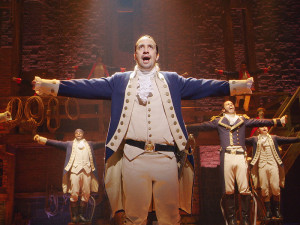By now, I think most people have at least heard of Hamilton: An American Musical. Based on the biography Alexander Hamilton by Ron Chernow, the music, lyrics, and book were all written by Lin-Manuel Miranda and tell the story of the life of founding father Alexander Hamilton through a hip hop musical. If you weren’t already overly-invested in Alexander Hamilton’s life (like I’ve been for the past few years), you will be after listening to this soundtrack. Trust me. One interesting idea that comes up repeatedly throughout the show is that of legacy and story-telling.

Hamilton wrote during his lifetime. A lot. In the musical, this is a point of interest. In “Non-Stop,” the fictionalized Aaron Burr asks Hamilton how he “write[s] day and night like [he’s] running out of time.” In the same song, we are informed of the Federalist Papers: John Jay wrote five, James Madison wrote twenty-five, and Hamilton wrote an astounding fifty-one. After Hamilton writes and publishes the Reynolds Pamphlet, his wife Eliza laments all the letters he has sent her and their “palaces built out of paragraphs.”
One of my favorite aspects of the show is how Miranda handles archives. He himself was creating a two-and-a-half-hour-long hip hop archive of Alexander Hamilton’s life when he wrote Hamilton, but even better is that his characters are aware that they’re being archived. George Washington is the first in the show to say that “history has its eyes on me.” He tells Hamilton this, and something else: “You have no control who lives, who dies, who tells your story.” The characters in Hamilton are fighting in the American Revolution and then building a new nation from the bottom up, so it’s appropriate that many of them express fear or uncertainty as to how future generations will look back at them.
In “Wait For It,” Burr sings of how his parents “left no instructions” when they died—“just a legacy to protect.” Eliza chastises Hamilton on his “obsess[ion] with [his] legacy.” Then, in a show of power, she burns his letters and proclaims, “I’m erasing myself from the narrative. Let future historians wonder how Eliza reacted when [Hamilton] broke her heart.” Finally, in the immediate wake of the Hamilton-Burr duel, Burr realizes that he has become “the villain in [our] history.”
However, one of the best moments of the show is only experienced live. At the end of the final number “Who Lives, Who Dies, Who Tells Your Story,” Eliza tells us that she has “put [her]self back in the narrative” and is attempting to sift through everything that Hamilton wrote in his life in order to tell his story. At the end of the song, she faces the audience, “breaking the fourth wall… surprised that so many people actually came to hear [Hamilton’s] story so many years in the future.” Eliza then gasps in wonder that her attempts to archive her husband’s life were successful.

Another interesting aspect of the archive is the cast itself. Every single character, with the exception of King George, is specifically described as “non-white.” I’ve seen some people say “so what?” about the cast, or “weren’t all the founding fathers white? This isn’t historically accurate!” Well, I hate to break it to you, but I’m fairly certain that the founding fathers also didn’t rap. Also, Alexander Hamilton’s nine-year-old son probably wasn’t actually twenty-four. But you know, whatever.
When the New York Times asked Miranda about his almost exclusively non-white cast, he said, “This is a story about America then, told by America now, and we want to eliminate any distance—our story should look the way our country looks.” He continued to say that when schools begin to do productions of Hamilton, “if this show ends up looking like the actual founding fathers, you messed up.”
In Interdisciplinarity, Joe Moran quotes Marwick: “For history is not simply an academic subject: the knowledge of the history of mankind should be a common property of humanity.” This is what Miranda is doing with Hamilton. He took the story of Alexander Hamilton and is telling it in a way that gives Hamilton a new legacy. Instead of just being that guy on the ten-dollar bill, he is the man whose story is being told again in 2015 in a United States where different revolutions are now being fought against police brutality and institutionalized racism. Miranda gifted us with Hamilton at a time when we needed it most, and although I can’t speak for him (because he probably wouldn’t want me to because he’s so vocal himself), I’m pretty sure the actual Alexander Hamilton would be pretty happy with where his legacy is now headed.
